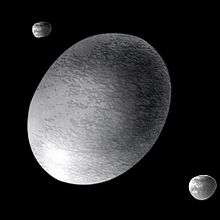2003 SQ317
| Discovery | |
|---|---|
| Discovered by | CFEPS |
| Discovery date | September 23, 2003 |
| Designations | |
| MPC designation | 2003 SQ317 |
| Cubewano (MPC)[1] | |
| Orbital characteristics[2] | |
| Epoch 13 January 2016 (JD 2457400.5) | |
| Uncertainty parameter 3 | |
| Observation arc | 3698 days (10.12 yr) |
| Aphelion | 45.751 AU (6.8443 Tm) |
| Perihelion | 39.238 AU (5.8699 Tm) |
| 42.494 AU (6.3570 Tm) | |
| Eccentricity | 0.076632 |
| 277.02 yr (101180 d) | |
| 3.4476° | |
| 0° 0m 12.809s /day | |
| Inclination | 28.631° |
| 176.347° | |
| 193.395° | |
| Earth MOID | 38.2411 AU (5.72079 Tm) |
| Jupiter MOID | 34.2935 AU (5.13023 Tm) |
| Physical characteristics | |
| Dimensions | 150–450 km[3] |
Mean density | 0.8–2.7 g/cm3[4] |
| 7.5 h (0.31 d) | |
Sidereal rotation period | 7.210 ± 0.001 h[4] |
| 0.05–0.50[4] | |
| Temperature | ~43 K |
| B−R=1.05 ± 0.18[4] | |
| 6.2[2] | |
|
| |
2003 SQ317 is a trans-Neptunian object (TNO) that resides in the Kuiper belt that was discovered on September 23, 2005, by the Canada-France Ecliptic Plane Survey (CFEPS). The surface of 2003 SQ317 is made of water ice.[5]
Physical properties
2003 SQ317 is a small classical Kuiper belt object (cubewano) belonging to the cold population. Its size estimated to lie between 150 and 450 km based on a range of plausible albedos. The object has a large light curve amplitude of about 0.85, which indicates that it has an extremely elongated shape or is a contact binary. In the former case the density of 2003 SQ317 is estimated at about 0.86 g/cm3 and its axis ratios at 0.55 and 0.41. If 2003 SQ317 is a contact binary, which is actually more likely, the density is estimated at about 2.67 g/cm3. In the latter case, the components are also thought to be unequal in size with the mass ratio of about 0.3 and axis ratios of about 0.8 and 0.5, respectively, for the primary and secondary components.[4]
Origin
2003 SQ317 was identified as a member of Haumea family, which is defined based on a common pattern of IR water-ice absorption, neutral visible spectrum and the clustering of the orbital elements. The Haumea family members including 2003 SQ317, (19308) 1996 TO66, (55636) 2002 TX300, (120178) 2003 OP32, (145453) 2005 RR43 and others all appear to be collisional fragments broken off of the dwarf planet Haumea.[5]
References
- ↑ "MPEC P22: DISTANT MINOR PLANETS (2006 Aug. 23.0 TT)". IAU Minor Planet Center. 2006-08-06. Retrieved 2016-02-17.
- 1 2 "JPL Small-Body Database Browser: (2003 SQ317)" (2004-11-02 last obs). Retrieved 30 March 2016.
- ↑ Dan Bruton. "Conversion of Absolute Magnitude to Diameter for Minor Planets". Department of Physics & Astronomy (Stephen F. Austin State University). Archived from the original on 23 March 2010. Retrieved 2009-12-27.
- 1 2 3 4 5 Pedro Lacerda; Andrew McNeill; Nuno Peixinho (2014). "The unusual Kuiper belt object 2003 SQ317". MNRAS. 437: 3824–3831. arXiv:1309.1671
 . Bibcode:2014MNRAS.437.3824L. doi:10.1093/mnras/stt2180.
. Bibcode:2014MNRAS.437.3824L. doi:10.1093/mnras/stt2180. - 1 2 Snodgrass, Carry; Dumas, Hainaut (16 December 2009). "Characterisation of candidate members of (136108) Haumea's family". Astronomy and Astrophysics. arXiv:0912.3171
 . Bibcode:2010A&A...511A..72S. doi:10.1051/0004-6361/200913031.
. Bibcode:2010A&A...511A..72S. doi:10.1051/0004-6361/200913031.
External links
- Orbital simulation from JPL (Java) / Horizons Ephemeris
- 2003 SQ317 at the JPL Small-Body Database

